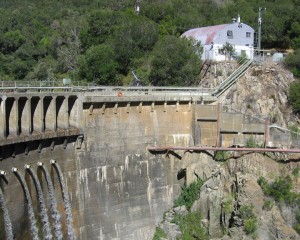Largest-ever Dam Removal Project in California Underway
The removal of the San Clemente Dam is now underway as part of an ambitious long-term effort to restore historic steelhead populations to the Upper Carmel River watershed, including portions of the Los Padres National Forest.

Image courtesy sanclementedamremoval.org
The 106-foot tall concrete arch dam along the Carmel River is located 18.5 miles upstream from the Pacific, and was built in 1921 to secure water for Monterey County. But over the course of its life, the dam eventually silted up to the point where it has lost 95 percent of its original water storage capacity.
In the 1990s, California’s Division of Safety of Dams declared the San Clemente “seismically unsafe,” and removal of the dam ultimately proved the most prudent option. The project will be funded by the dam’s owner, California American Water, along with public and private sources.
The dam removal project will restore historic steelhead access to prime spawning and rearing habitat in Pine Creek and in the South Fork Black Rock Creek, tributaries to the Carmel River that begin in the Ventana Wilderness in the Los Padres National Forest. The Carmel River historically supported steelhead runs in the thousands, but the numbers have been in serious decline for decades, with counts hitting such a low in the 1990s that the run was declared to be “nearly extinct” by the California Department of Fish and Game. The dam removal will also re‐establish a healthy connection between the lower Carmel River and the watershed above San Clemente Dam in the Los Padres National Forest, improve habitat for the California Red-Legged frog, and replenish sand along Carmel Beach.

Image courtesy sanclementedamremoval.org
The $83 million project will entail the construction of a new half-mile channel around the reservoir and divert the river around 2.5 million cubic yards of sediment which have accumulated behind the dam over the past 92 years. The new section of river will include a series of pools fashioned out of concrete sourced from the condemned dam, providing endangered steelhead trout access to the upstream spawning habitat for the first time since the dam’s construction.
Further, California American Water is donating 928 acres of property around the dam to the BLM, who is working with the Monterey Peninsula Regional Park District to develop recreational trails for use by the public.
“We hope this undertaking inspires efforts to restore access to historic spawning grounds on other rivers in the forest,” wrote Los Padres ForestWatch Executive Director Jeff Kuyper in a May 2013 letter to the Monterey County Planning Commission supporting the dam’s removal.
Chief among such efforts are the removal of Matilija Dam, facilitating passage around the Vern Freeman diversion dam to restore steelhead populations on Sespe Creek, modifying stream flows downstream of Twitchell Reservoir so that there’s enough water for steelhead to access the Sisquoc River, and evaluating steelhead passage around Santa Felicia Dam on Piru Creek and Bradbury Dam on the Santa Ynez River. All of these activities are currently ongoing and will take years to complete, “but San Clemente Dam is a good start,” Kuyper states.
For more information about the project, visit the official San Clemente Dam Removal project site.







Comments are closed.